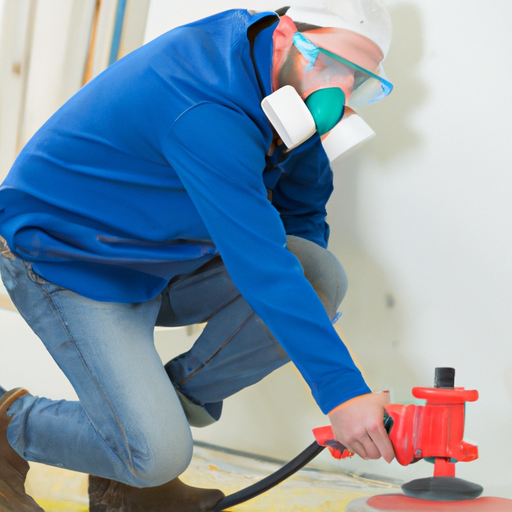
Working with polyurethane, especially in the form of spray foam, can be a game-changer for many woodworking and insulation projects.
However, like many chemical products, it comes with its own set of safety precautions that need to be adhered to.
This article will delve deep into the safety measures one should take when working with polyurethane.
Key Takeaways:
- Always be aware of the potential health risks associated with polyurethane.
- Proper ventilation and protective gear are essential.
- Be cautious about re-occupancy times after application.
- Understand the factors that impact curing rates.
Understanding the Risks
Polyurethane, especially in its spray form, is an effective insulation and air sealant material. However, exposure to its key ingredient, isocyanates, and other chemicals during and post-installation can lead to adverse health effects. Some of these include:
- Asthma, which can be life-threatening.
- Sensitization leading to asthma attacks upon re-exposure.
- Lung damage.
- Other respiratory and breathing problems.
- Skin and eye irritation.
It’s crucial to be aware of these risks and take all necessary precautions to avoid them.
Safety First: Protective Measures
When working with polyurethane, especially in spray form, it’s essential to:
- Review Product Information: Always check the label and product details for ingredients, hazards, directions, safe work practices, and precautions.
- Undergo Training: Ensure that all workers have completed health and safety training and are following safe work practices.
- Use Protective Gear: This includes masks, gloves, and safety goggles to prevent eye, skin, and inhalation exposures.
- Ventilation: Make sure the workspace is well-ventilated to avoid inhaling fumes.
- Re-occupancy: Be cautious about when it’s safe to re-enter a space after polyurethane has been applied. This can vary based on the product and environmental conditions.
Re-occupancy Times
One of the critical aspects to consider is the time it takes for polyurethane to cure and when it’s safe for unprotected workers or building occupants to re-enter. Some manufacturers recommend 24 hours after application for professional SPF systems, but this can vary. Factors affecting curing rates include:
- Ambient conditions like temperature and humidity.
- Workplace practices.
- Applicator technique.
It’s essential to consult with the manufacturer or supplier for specific guidance on ventilation, re-entry, and re-occupancy times.
External Resources for Safety
For more in-depth information on safety precautions when working with polyurethane, consider checking out the following resources:
- Quick Safety Tips for Spray Polyurethane Foam Users | US EPA
- How to Use Polyurethane Coatings Safely – CoatingsPro Magazine
- What are the safety precautions when processing polyurethanes? – Gianeco
YouTube Resources
For visual learners, here are some YouTube videos that delve into the safety precautions when working with polyurethane:
Internal Links
For more related articles and insights, consider checking out these internal links:
Understanding the Risks
Polyurethane is a versatile material used in various applications, especially in woodworking. However, it comes with its own set of risks. When working with polyurethane, especially in its liquid form, there’s a risk of skin contact, inhalation, and even ingestion.

Inhalation: The fumes from polyurethane can be harmful when inhaled. Prolonged exposure can lead to respiratory issues, headaches, and dizziness.
Skin Contact: Direct contact can cause skin irritation. In some cases, it might also lead to allergic reactions.
Ingestion: Accidental ingestion can be harmful and lead to poisoning.
Safety Measures to Adopt
1. Proper Ventilation
Always work in a well-ventilated area. This ensures that the fumes from the polyurethane dissipate quickly, reducing the risk of inhalation. If you’re working indoors, open windows and doors, and consider using fans to improve airflow.
2. Use of Personal Protective Equipment (PPE)
- Gloves: Wear chemical-resistant gloves to prevent direct skin contact.
- Respirator: If you’re working in an area with poor ventilation or for extended periods, use a respirator to protect against inhalation of fumes.
- Safety Glasses: Protect your eyes from any accidental splashes.

3. Safe Storage
Store polyurethane containers in a cool, dry place away from direct sunlight. Ensure the lids are tightly sealed to prevent any accidental spills or exposure to air, which can degrade the quality of the polyurethane.
4. Immediate Cleanup
In case of any spills, clean up immediately using a cloth. For dried polyurethane, consider using a scraper or a solution that can dissolve it.
5. Disposal
Dispose of any rags or materials used in the cleanup process safely. Some might be flammable, especially if they’ve been soaked in solvents.
Emergency Measures
In case of accidental ingestion or if someone inhales the fumes for a prolonged period, seek medical attention immediately. If polyurethane comes into contact with the eyes, rinse thoroughly with water and consult a doctor.
Additional Resources
For more insights and safety tips, consider watching these videos:
- Free Low-Pressure Spray Polyurethane Foam Safety Training
- 2k Poly Isocyanate Safety talk with Eric Reason and Michael Craine
- Isocyanates: Talking 2K with Ryan Denny | Part 3 | Polyurethane | General Finishes
Further Reading
For more detailed information on working safely with polyurethane and other related topics, consider visiting these articles from String Pulp:
- 10 Effective ways on How to get polyurethane off hands?
- 5 Effective Woodworking Tips for Beginners
- How to Choose the Right Jigsaw Blade for Cutting Curves?
Frequently Asked Questions
1. Is Polyurethane Flammable?
Yes, polyurethane in its liquid form is flammable. Always keep it away from open flames or sources of ignition.
2. Can I Use Regular Gloves When Working with Polyurethane?
It’s recommended to use chemical-resistant gloves as regular gloves might not offer adequate protection against polyurethane.
3. How Long Should I Wait Before Applying a Second Coat of Polyurethane?
It depends on the type of polyurethane and the conditions in your working area. Always refer to the manufacturer’s instructions for the best results.
Remember, safety should always be a priority when working with any chemical or material. By following the precautions mentioned above, you can ensure a safe and efficient working environment.
